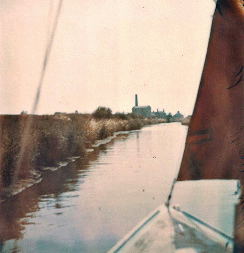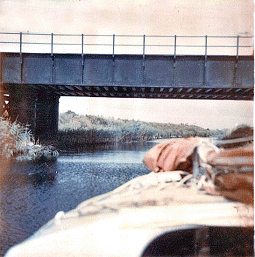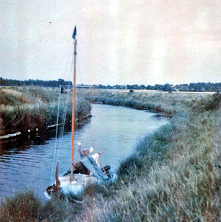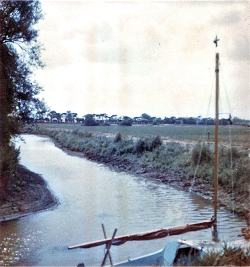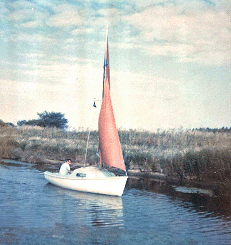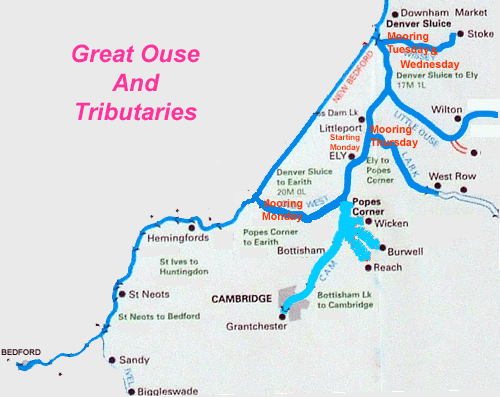|
1918
|
The Ouse Drainage Board was established (confirmed by Act of Parliament in 1920
|
|
December 1930
|
River Great Ouse Catchment Board took over from the Ouse Drainage Board under powers in the Land Drainage Act 1930
|
|
1931
|
The locks at St. Ives, Hemingford, Houghton and Godmanchester were restored by the RCOCB with a guillotine gate replacing one set of mitre gates at each site. This was to enable the locks to be used to discharge flood water but also to enable its maintenance craft to be moved around more effectively.
|
|
1933
|
J. R. Eve & Sons of Bedford, surveyors to the RGOCB, reported on the navigation
|
|
November 1935
|
The RGOCB purchased the navigation rights from the owner Leonard Thomas Simpson for £30.
|
|
1935
|
Brownshill Staunch renovated with a guillotine gate being installed.
|
|
1937
|
Brampton and Offord Locks restored
|
|
1938
|
St. Neots and Eaton Socon Locks restored and Belford Staunch eliminated.
|
1939 - 1945
Second World War.
|
After the war financial stringencies throughout the country prevented any thoughts of the pre-war work being extended from Tempsford up to Bedford. Likewise much of the RGOCB's plant was now land-based eliminating part of the justification to restore the locks.
|
|
30 October 1949
|
Fenlands Branch of the Inland Waterways Association founded at a meeting at the George Hotel in Huntingdon.
|
|
April 1950
|
Bedford Boat Club founded
|
|
7 June 1950
|
Survey of the river from Bedford to Tempsford undertaken by IWA members A.S. Cavender, L. H. Jones and F. W. White.
|
|
20 February 1951
|
Public meeting held in Bedford's Town Hall addressed by Robert Aickman and Peter Scott and which decided on the setting up of a restoration society.
|
|
20 March 1951 |
Initial meeting of the new society's officers at the Swan Hotel, Bedford. The society to be called "The Great Ouse Restoration Council".
|
|
16 April 1951
|
First general meeting of the new society at the Town Hall, Bedford; the society to be called "The Great Ouse Restoration Society"
|
|
2 January1952
|
Restoration of the river from Tempsford to Bedford estimated at £77,000 by Mr. W. E. Doran, Chief Engineer of the RGOCB. The plan included eliminating Tempsford and Castle Mills staunches and Great Barford Lock
|
|
1 April 1952
|
The Great Ouse River Board took over from the River Great Ouse Catchment Board under the powers of the 1948 River Boards Act.
|
|
1953
|
The annual Bedford to St. Neots canoe race inaugurated by the Bedford Kayak Club.
|
7 March 1955
(Monday)
|
Using its own labour, the GORB started work on restoring Bedford Town Lock on a scheme that was also to include Cardington Lock. The combined cost was estimated at £10,000 towards which the GORS agreed to pay £2,500
.
|
23 September 1955
(Saturday)
|
The first boat passed through Bedford Town Lock. A guillotine gate was installed at the head of the lock, the chamber was refurbished and new wooden bottom mitre gates were fitted. Financial stringency prevented the GORB moving on to Cardington and the GORS just paid £1,250 towards the £6,250 cost of Bedford.
|
31 March 1956
(Easter Saturday)
|
Formal opening of the restored Bedford Town Lock by the Mayor of Bedford
|
|
July 1956
|
Silvery Ouse Pleasure Craft launched a shuttle service involving its three launches to take visitors from Bedford Town Bridge through the lock to the Bedfordshire Agricultural Showground on the Cardington Road and bring them back. The service lasted several years, but latterly took visitors along the Embankment to Newnham Bridge, rather than using the lock.
|
|
11 June 1961
|
The GORS launched its first voluntary work party at Great Barford Lock to clear out the lock chamber and draw attention to the state of the river.
|
|
25 June 1961
|
The GORS launched its first work party at Roxton. These sessions continued for the rest of the summer and were resumed at both locations in 1962.
|
|
7 September 1961
|
New £221,800 estimate by Mr W. E. Doran, Chief Engineer of the GORB, of the combined land drainage and navigation costs for restoring the river. It involved eliminating Tempsford and Castle Mills staunches and Old Mills Lock.
|
|
October 1961
|
The GORS launched its new quarterly journal - "The Lockgate".
|
|
3 September 1962
|
Contractors W. & C. French Ltd started work on a £15,000 scheme to restore Cardington Lock. The contract did not include fitting bottom lock gates, as there were not needed for land drainage purposes.
|
17 May 1963
(Saturday)
|
Formal re-opening of Cardington Lock by Harold Goodwin, Chairman of the GORS, when a contingent of boats from the Bedford Boat Club passed through the lock. A guillotine top gate was fitted and the lock walls were repaired by lining them with a steel mesh covered with a thick sprayed-on layer of concrete, hence making this the narrowest lock on the river. The GORS paid £1,000 which covered the installation of steel mitre bottom gates together with the provision of step ladders and safety chains in the chamber.
|
|
1 April 1964
|
Under the powers of the 1963 Water Resources Act the Great Ouse River Authority took over from the Great Ouse River Board.
|
|
January 1968
|
The GORA announced a land drainage and water-measuring scheme at Roxton.
|
|
30 August - 3 September 1968
|
St Neots Waterways Rally organised jointly by the GORS and the St. Neots Carnival Committee held to campaign for and draw attention to the river.
|
|
1 April 1970
|
The GORB's Byelaws were approved by the Ministry of Agriculture and Fisheries authorising the registration of private pleasure boats and hire boats on the Great Ouse and the payment of an annual fee.
|
|
14 June 1971
|
The Dredging & Construction Co. Ltd of Kings Lynn started work on a completely new lock at Roxton.
|
12 August 1972
(Saturday)
|
The new lock at Roxton was formally opened by the Duke of Bedford, Vice President of the GORS, accompanied by Leonard Childs, Chairman of the GORA. The work, which cost £80,200, involved a new concrete lock with steel mitre gates at both ends, a wide measuring weir alongside and a footbridge crossing the site. At the same time the staunch downstream at Tempsford was removed, a new footbridge was installed there and the river was dredged up to the new lock. Some dredging also took place upstream towards Great Barford. The GORS contributed £5,000 to the overall costs.
|
|
1974
|
For some time the GORA had stated that there would be no land drainage benefit in restoring the lock at Great Barford and hence none of the cost could fall on the land drainage budget, which had funded most of the costs at Roxton. The impasse was resolved when Bedford Town Council announced it would contribute £100,000 from the sale of aggregates from riverside land at Bedford to the work at Great Barford. The GORS, in partnership with the Cambridge Branch of the Inland Waterways Association and the Waterway Recovery Group, agreed to provide volunteers to carry out part of the work, and the GORS offered £5,000 to the overall costs.
|
|
11 March 1974
|
The authorities started work at Great Barford to create an access road and start dredging a bypass canal round the site into which to divert the river and hence drain the worksite.
|
|
1 April 1974
|
The Anglian Waterway Authority took over from the Great Ouse River Authority
|
|
4 May 1964
|
Volunteers from the IWA and the GORS started work on demolishing the lock and sluice islands at Great
|
|
4 June 1974
|
The river at Great Barford was diverted from the work site with the completion of the bypass canal and two dams.
|
|
7 September 1974
|
The volunteers completed the removal of the lock island. The bricks recovered from this and the sluice island were used to fill gabions to form the new river bank Meanwhile the AWA, using its own labour, had just begun laying the foundations for a new lock to be built just downstream of the old lock site. The site was flooded in November by high river levels.
|
|
2 June 1975
|
Contractors May Gurney & Co. Ltd of Norwich started work on a new lock at Willington.
|
6 May 1976
(Saturday)
|
Formal opening of both Great Barford and Willington Locks by Mr A. F. Skinner, Chairman of the Anglian Water Authority and Mr D. K. Cassels, Chairman of the GORS. Great Barford was designated as a conservation site and the new lock was constructed to a high standard with a brick chamber, two sets of steel mitre gates, with a new wide weir and a footbridge over the river. Other work included deepening one of the arches under the Great Barford Bridge and extensive dredging upstream past the site of Old Mills Lock to Willington. At Willington the new lock comprised a concrete chamber, two sets of steel mitre gates, a wide new weir and a new footbridge across the river. The work at Great Barford cost £190,000 and that at Willington £245,000 with the GORS paying £5,000 towards each project. Old Mills Lock was by-passed and left un-restored.
|
|
12/13 June 1976
|
Elizabethan Feast and Rally of Boats held at Great Barford. This produced £1,565 to the GORS's funds whilst a draw organised by Mr. A. S Lain for a Shetland Cruiser raised £2,686.
|
|
31 August 1976
|
Contractors French Kier Ltd of Tempsford started work on a new lock at Castle Mills, Goldington.
|
28 April 1978
(Friday)
|
Low-key opening of the new lock at Castle Mills by Mr E. H. Burton, Chairman of Anglian Water Authority's Great Ouse Land Drainage Committee and Mr. D. K. Cassels, Chairman of the GORS. The lock has a deep concrete chamber -the deepest on the river - with steel mitre gates, a wide new weir and a bridge over the site. At the same time the former staunch a short distance downstream was demolished and the river was extensively dredged up to the new lock. The work cost some £370,000 towards which the GORS paid its usual £5,000 contribution.
|
|
27/29 May 1978
|
The Bedford River Festival celebrated the re-opening of the river through to Bedford.
|
|
25 January 1979
|
Its objectives completed, the GORS held its final meeting and disbanded.
|




